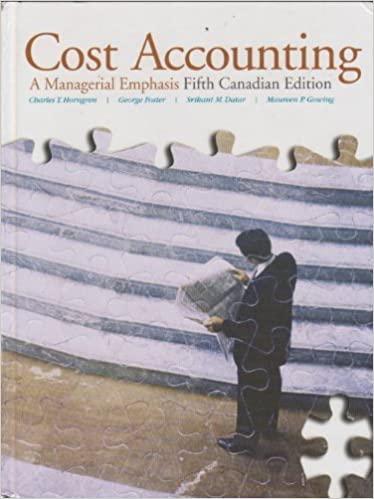Question
[The following information applies to the questions displayed below.] Trico Company set the following standard unit costs for its single product. Direct materials (28 Ibs.
[The following information applies to the questions displayed below.]
| Trico Company set the following standard unit costs for its single product. |
| Direct materials (28 Ibs. @ $4 per Ib.) | $ | 112.00 |
| Direct labor (8 hrs. @ $8 per hr.) | 64.00 | |
| Factory overheadvariable (8 hrs. @ $5 per hr.) | 40.00 | |
| Factory overheadfixed (8 hrs. @ $7 per hr.) | 56.00 | |
| Total standard cost | $ | 272.00 |
| The predetermined overhead rate is based on a planned operating volume of 70% of the productive capacity of 60,000 units per quarter. The following flexible budget information is available. |
| Operating Levels | ||||||
| 60% | 70% | 80% | ||||
| Production in units | 36,000 | 42,000 | 48,000 | |||
| Standard direct labor hours | 288,000 | 336,000 | 384,000 | |||
| Budgeted overhead | ||||||
| Fixed factory overhead | $ | 2,352,000 | $ | 2,352,000 | $ | 2,352,000 |
| Variable factory overhead | $ | 1,440,000 | $ | 1,680,000 | $ | 1,920,000 |
| During the current quarter, the company operated at 80% of capacity and produced 48,000 units of product; actual direct labor totaled 379,000 hours. Units produced were assigned the following standard costs: |
| Direct materials (1,344,000 Ibs. @ $4 per Ib.) | $ | 5,376,000 |
| Direct labor (384,000 hrs. @ $8 per hr.) | 3,072,000 | |
| Factory overhead (384,000 hrs. @ $12 per hr.) | 4,608,000 | |
| Total standard cost | $ | 13,056,000 |
| Actual costs incurred during the current quarter follow: |
| Direct materials (1,339,000 Ibs. @ $4.10 per lb.) | $ | 5,489,900 |
| Direct labor (379,000 hrs. @ $7.75 per hr.) | 2,937,250 | |
| Fixed factory overhead costs | 3,360,943 | |
| Variable factory overhead costs | 3,146,415 | |
| Total actual costs | $ | 14,934,508 |
4.
Required information
| Required: | |
| 1. | Compute the direct materials cost variance, including its price and quantity variances. |
5.
Required information
| 2. | Compute the direct labor variance, including its rate and efficiency variances. |
6.
Required information
| 3. | Compute the overhead controllable and volume variances. |
Step by Step Solution
There are 3 Steps involved in it
Step: 1

Get Instant Access to Expert-Tailored Solutions
See step-by-step solutions with expert insights and AI powered tools for academic success
Step: 2

Step: 3

Ace Your Homework with AI
Get the answers you need in no time with our AI-driven, step-by-step assistance
Get Started


